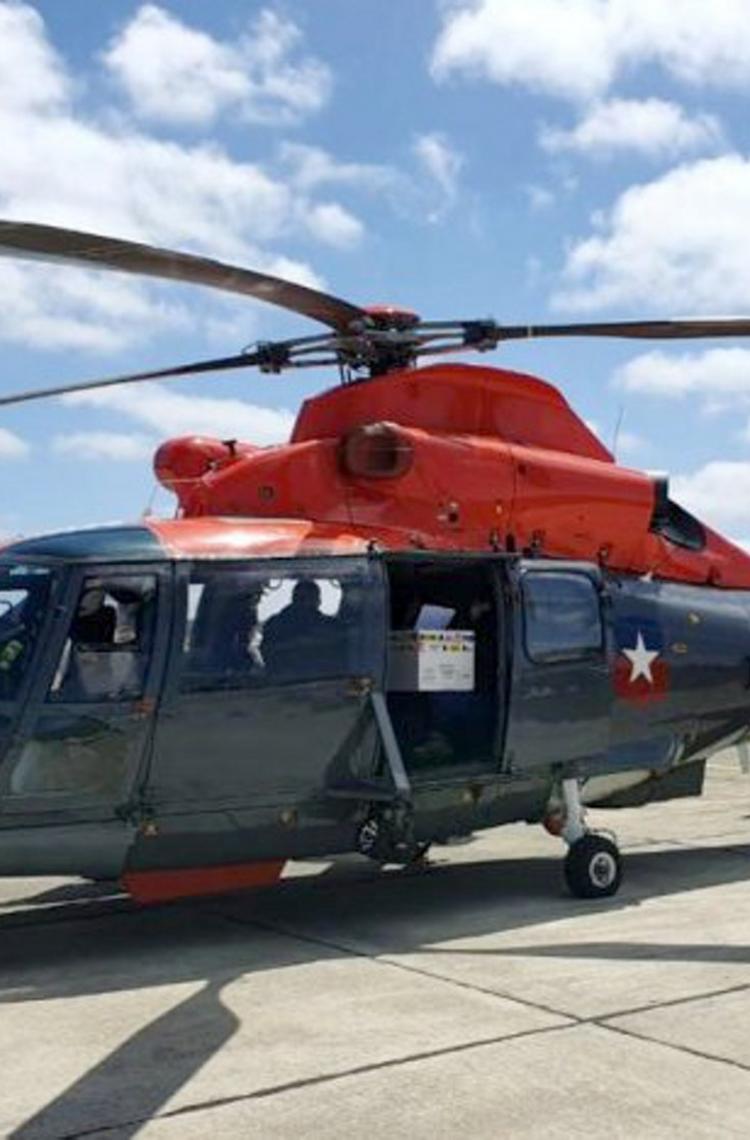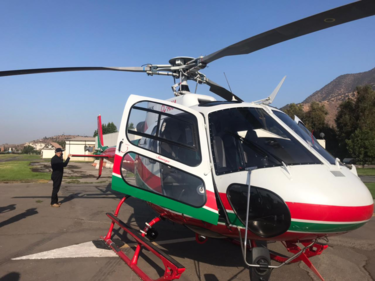COVID-19 vaccines in remote locations: Airbus helicopters rise to the challenge

The speed and extraordinary ability of helicopters to reach remote locations make them an essential component for accomplishing the last leg of the logistical challenge involved in distributing COVID-19 vaccines to isolated areas.
Today, more than 30 countries are engaged in mass vaccination campaigns to protect populations against the coronavirus, with Airbus-built rotorcraft providing vital airlift services in locations around the world. Many Airbus helicopter types are being deployed by military services, government agencies and civil operators – from the single-engine, H125 light utility version to the twin-engine heavy-lift H225M.
Chile: Civil and military helicopters for a common goal
Since the end of 2020, Chilean authorities have been deploying helicopters and aircraft to distribute Pfizer-BioNTech vaccines in different regions of the country. This airlift includes a BK117 from the Prefectura Aérea de Carabineros and a Chilean Navy AS365 Panther.
The H125 offers many benefits for getting vaccines to remote and high-altitude locations.
- José Luis Bendicho, Suma Air’s General Manager
Additionally, a Suma Air H125 transported 85 doses of the COVID-19 vaccine from Santiago to Quillota Hospital. “The helicopter is an excellent alternative to transferring vaccines in optimal conditions – providing a fast, timely and efficient way to reach locations that would be difficult to access without the proper means of transportation,” explained José Luis Bendicho, General Manager of Suma Air. “The H125 offers many benefits for getting vaccines to remote and high-altitude locations.”

A Suma Air H125 transported 85 doses of the COVID-19 vaccine from Santiago to Quillota Hospital.
Brazil: A challenge across more than 8.5 million square kilometres
In Brazil, helicopters of the armed forces and public security bodies are working together in dispatching vaccines across the country’s different states. Distribution is carried out centrally: the government receives the vaccines and passes them along for the states to administer. The country has a large and efficient vaccination network, with extensive experience gained through annual vaccination campaigns.
In Minas Gerais, the local fire brigade’s two H125 helicopters and one fixed-wing aircraft have been tasked with distributing 560,000 vaccine doses in the state. Public security H125s also were in charge of transporting a share of the 70,000 doses in the state of Alagoas, while in the state of Ceará, it was the H145 of CIOPAer (a unit specialised in the use of helicopters for major public security operations) that was tasked for vaccine deliveries to the most remote areas.
Mexico: The H225M and Panther on duty
After the first large shipment of vaccines arrived in Mexico, the government launched a coordinated dispersal plan with the establishment of eight air routes for the distribution of approximately 440,000 doses of Pfizer-BioNTech vaccines.
The Secretariat of National Defense (SEDENA) deployed eight aircraft, including an H225M helicopter and three Airbus-built C295 fixed-wing aircraft, to deliver shipments across 25 states in southern, central and northwestern Mexico in less than 24 hours. The country’s navy also has been using a Panther AS565 MB helicopter to carry 200 vaccine doses from Hermosillo to Puerto Peñasco.
Spain and France: Island and coastal delivery
In Spain, the armed forces have taken charge of dispatching vaccines via air from Getafe (near Madrid) to the Canary Islands and the Balearic Islands, along with the Spanish autonomous cities of Ceuta and Melilla on Africa’s north coast. For Ceuta, the chosen transportation method was a Spanish Army H215M Cougar that transported the vaccines in containers with dry ice to keep them at -76º Celsius.
Beginning in late January, the helicopter fleet of France’s Securité Civile government agency began transporting vaccines to the Brittany Islands (Groix, Houat, Hoedic, etc.) off the coast of western France. During the initial operations, teams managed to vaccinate 77 people on the Île d’Arz, followed by the helicopter delivery of 100 doses to the Hoedic and Houat islands.
Transporting ultra-cold vaccines aboard aircraft
The transportation of vaccines requires storage temperatures between +2 and -70 degrees Celsius, depending on the ingredients used for their immunisation technology. Dry ice – the frozen form of CO2 – enables their shipment at -70 degrees Celsius, which is necessary for RNA-based vaccines when they will not be used within a few days.
Helicopters are the last leg in the chain of transportation and often deliver vaccines that are administered to patients within a few days. For this reason, they are not usually called upon to transport vaccines that require ultra-cold temperatures. However, they have been on occasion, and are up to the challenge when necessary.
As dry ice is considered hazardous due to the potential of excessive CO2 is concentration, the airlift of cold-storage COVID-19 vaccines aboard helicopters follows the same rules as in the transport of dangerous goods on airplanes – and requires additional precautionary measures from operators.
Airbus Commercial Aircraft has issued an information pack for operators that includes an updated “Service Information Letter” (SIL) with the company’s input on airworthiness authorities’ recommendations for transporting dry ice in larger quantities. It reminds operators of the health and safety considerations/measures (particularly regarding ventilation) to be respected during the loading and airlift of vaccines packed in dry ice. In particular, the information includes guidance on limits for amounts of dry ice in accordance with regulations.